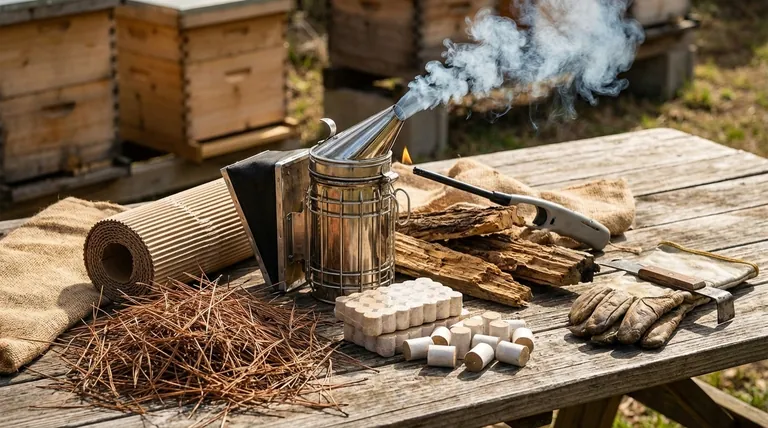To create smoke, beekeepers use a variety of natural, slow-burning fuels. Common choices include burlap (Hessian fabric), dry pine needles, corrugated cardboard, paper egg cartons, and rotten wood. Some also use commercially prepared fuels made from compressed cotton or pulped paper.
The primary goal is not simply to create smoke, but to generate a cool, white smoke that pacifies the bees without harming them. The fuel choice is critical for masking alarm signals and allowing the beekeeper to work safely.

How Smoke Calms a Beehive
Masking the Alarm Signal
When bees feel threatened, they release an alarm pheromone known as isopentyl acetate. This chemical signal instantly alerts other bees in the colony to become defensive and prepare to attack.
The smoke from a beekeeper's smoker effectively masks this pheromone. By interrupting this chemical communication, the smoke prevents a coordinated defensive response from the hive, keeping the colony in a calmer state.
Allowing for Safe Inspection
With the alarm system neutralized, the beekeeper can open and inspect the hive. This process is essential for checking the queen's health, looking for pests or diseases, and managing the colony's resources. The smoke allows this to be done with minimal stress to both the bees and the beekeeper.
Common Types of Smoker Fuel
Natural and Foraged Fuels
Many beekeepers prefer to use materials that are readily available and free. The key is that the material must be dry and free of chemicals.
- Pine Needles: A very popular choice, as they are easy to light and produce a pleasant-smelling smoke.
- Burlap (Hessian Fabric): This classic fuel smolders for a long time but must be from natural fibers, not synthetic sacks.
- Corrugated Cardboard: Rolls of cardboard without ink or glossy coatings work well.
- Rotten or "Punky" Wood: Decomposing wood is ideal because it smolders slowly rather than producing hot flames.
Commercial Fuels
For convenience and consistency, many beekeeping suppliers sell specially prepared fuels.
- Compressed Cotton: These are dense blocks of raw cotton that provide a long, steady smolder.
- Pulped Paper: Often sold in pellet form, these are easy to light and use.
Adding Herbs
Some beekeepers add dried herbs like lavender or thyme on top of their primary fuel. While not essential for calming the bees, it creates a more pleasant-smelling smoke.
Understanding the Trade-offs and Dangers
The Goal: Cool, White Smoke
The objective is always a thick, cool smoke, not hot smoke or open flames. Hot smoke will anger and harm the bees, making an inspection more difficult and dangerous. The fuel should smolder, not burn.
What to Absolutely Avoid
Never burn materials that contain synthetic chemicals, plastics, or glues. This includes treated lumber, glossy magazine paper, or dryer lint that may contain synthetic fibers. The toxic fumes can be lethal to the bees and can contaminate the honey and wax.
The Risk of Over-Smoking
Smoke is a tool, not a weapon. Using too much smoke can be counterproductive. It can overly disrupt the colony, drive the bees out of the hive, and impart a smoky flavor to the honey. A few gentle puffs at the entrance and under the lid is usually sufficient.
Making the Right Choice for Your Goal
- If your primary focus is accessibility and low cost: Use natural, foraged materials like dry pine needles, untreated cardboard, or punky wood from your local environment.
- If your primary focus is convenience and a consistent burn: Purchase commercial smoker fuels made from compressed cotton or paper pellets from a beekeeping supplier.
- If your primary focus is a gentle and pleasant scent: Consider adding dried, non-toxic herbs like lavender on top of your primary fuel once it is smoldering well.
Ultimately, selecting the right fuel is a fundamental skill for calm, safe, and responsible beekeeping.
Summary Table:
| Fuel Type | Examples | Key Characteristics |
|---|---|---|
| Natural/Forged | Pine needles, burlap, rotten wood, cardboard | Low cost, readily available, must be dry and chemical-free. |
| Commercial | Compressed cotton, pulped paper pellets | Convenient, consistent burn, easy to light. |
| Avoid | Treated wood, plastics, glossy paper | Produces toxic fumes harmful to bees and honey. |
Ensure your apiary operations run smoothly with the right equipment. HONESTBEE supplies high-quality beekeeping supplies and equipment, including reliable smokers and safe fuels, to commercial apiaries and distributors through our wholesale-focused operations. Our products are designed to help you manage your hives safely and efficiently. Contact HONESTBEE today to discuss your supply needs and discover how we can support your business.
Visual Guide

Related Products
- 54-Piece Smoker Fuel Pellets for Beekeeping Beehive Smoker Fuel
- Premium Traditional Copper Bee Smoker with Bellows
- Stainless Steel Honey Bee Smoker Hive and Honeycomb Smoker for Beekeeping
- Economy Galvanized Beekeeping Honey Bee Smoker for Wholesale
- European Stainless Steel Bee Smoker for Honey Bee Hive
People Also Ask
- What is the best bee hive smoker fuel? Choose Natural, Slow-Burning Fuel for Calm Bees
- What is best to burn in a bee smoker? Master the Layered Fuel Technique for Calm Hives
- What to put in a bee hive smoker? A Guide to Natural, Calming Fuels
- What fuels are recommended for beehive smokers? Master the Art of Calm, Controlled Inspections
- What is used in a bee smoker? Master the Best Fuels for Calm, Healthy Hives



















